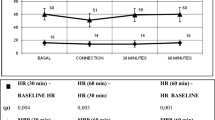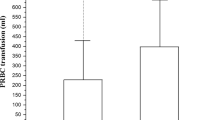Abstract
Objectives
The basic materials and structure of a hemoconcentrator incorporated into cardiopulmonary bypass (CPB) circuits are similar to those of hemodialyzers. Gravity drainage hemodiafiltration (GHDF) is an easy-to-use intraoperative renal replacement therapy (RRT) that utilizes a hemoconcentrator. This study aimed to verify whether GHDF can correct electrolyte imbalance and remove uremic toxins in dialysis-dependent patients and to evaluate the clinical outcomes of GHDF by comparing it with a conventional method of dilutional ultrafiltration (DUF).
Methods
This study retrospectively compared perioperative clinical values of 41 dialysis-dependent patients (21 patients with GHDF and 20 patients with DUF) who underwent open-heart surgery. Changes in serum parameters before and after passing through the hemoconcentrator were also compared.
Results
Compared to DUF, GHDF significantly lowered potassium, blood urea nitrogen, and creatinine levels at the outflow of the hemoconcentrator. Less catecholamine was needed to wean CPB in GHDF than in DUF. The P/F ratio (arterial blood oxygen pressure/inhaled oxygen concentration) at the end of surgery was significantly higher in GHDF than in DUF (450.8 ± 149.7 vs. 279.3 ± 153.5; p < 0.001). Postoperative intubation time was shorter in GHDF than in DUF (8.3 ± 5.9 vs. 18.7 ± 16.1 h; p = 0.006). The major morbidity and mortality rates were comparable in both groups.
Conclusions
GHDF removed both potassium and uremic toxins more efficiently than DUF in dialysis-dependent patients. Less catecholamine was needed to wean CPB using GHDF. It improved the immediate postoperative respiratory function and enabled earlier extubation. GHDF is a novel and effective option for intraoperative RRT in dialysis-dependent patients undergoing open-heart surgery.


Similar content being viewed by others
Abbreviations
- HD:
-
Hemodialysis
- GHDF:
-
Gravity drainage hemodiafiltration
- DUF:
-
Dilutional ultrafiltration
- CHDF:
-
Continuous hemodiafiltration
- RRT:
-
Renal replacement therapy
References
Kamohara K, Yoshikai M, Yunoki J, Fumoto H. Safety of perioperative hemodialysis and continuous hemodiafiltration for dialysis patients with cardiac surgery. Gen Thorac Cardiovasc Surg. 2007;55:43–9.
Murkin JM, Murphy DA, Finlayson DC, Waller JL. Hemodialysis during cardiopulmonary bypass: report of twelve cases. Anesth Analg. 1987;66:899–901.
Ilson BE, Bland PS, Jorkasky DK, Shusterman N, Allison NL, Dubb JW, et al. Intraoperative versus routine hemodialysis in end-stage renal disease patients undergoing open-heart surgery. Nephron. 1992;61:170–5.
Khoo MS, Braden GL, Deaton D, Owen S, Germain M, O’Shea M, et al. Outcome and complications of intraoperative hemodialysis during cardiopulmonary bypass with potassium-rich cardioplegia. Am J Kidney Dis. 2003;41:1247–56.
Hakim M, Wheeldon D, Bethune DW, Milstein BB, English TA, Wallwork J. Haemodialysis and haemofiltration on cardiopulmonary bypass. Thorax. 1985;40:101–6.
Frenken M, Krian A. Cardiovascular operations in patients with dialysis-dependent renal failure. Ann Thorac Surg. 1999;68:887–93.
Franga DL, Kratz JM, Crumbley AJ, Zellner JL, Stroud MR, Crawford FA. Early and long-term results of coronary artery bypass grafting in dialysis patients. Ann Thorac Surg. 2000;70:813–8.
Hirai K, Sasaki A, Kondo T, Akiyama T, Kanauchi A, Amada N, et al. Development and clinical evaluation of gravity drainage type hemodiafiltration method for correction of hyperkalemia during extracorporeal circulation in open heart surgery. Jpn J Extra-Corporeal Technol. 2013;40:149–54.
Hashimoto K, Nogimoto T, Tani S, Fujikawa D, Nakao Y. The usefulness of gravity drainage hemodiafiltration in the management of hyperkalemia. Jpn J Extra-Corporeal Technology. 2017;44:385–9.
Journois D, Israel-Biet D, Pouard P, Rolland B, Silvester W, Vouhé P, et al. High-volume, zero-balanced hemofiltration to reduce delayed inflammatory response to cardiopulmonary bypass in children. Anesthesiology. 1996;85:965–76.
Heath M, Barbeito A, Welsby I, Maxwell C, Iribarne A, Raghunathan K. Using zero-balance ultrafiltration with dialysate as a replacement solution for toxin and eptifibatide removal on a dialysis-dependent patient during cardiopulmonary bypass. J Cardiothorac Vasc Anesth. 2016;30:162–8.
Huang H, Yao T, Wang W, Zhu D, Zhang W, Chen H, et al. Continuous ultrafiltration attenuates the pulmonary injury that follows open heart surgery with cardiopulmonary bypass. Ann Thorac Surg. 2003;76:136–40.
Yamashita C, Hara Y, Kuriyama N, Nakamura T, Nishida O. Clinical effects of a longer duration of polymyxin b-immobilized fiber column direct hemoperfusion therapy for severe sepsis and septic shock. Ther Apher Dial. 2015;19:316–23.
Motomura N, Miyata H, Tsukihara H, Takamoto S. Japan Cardiovascular Surgery Database Organization. Risk model of thoracic aortic surgery in 4707 cases from a nationwide single-race population through a web-based data entry system: the first report of 30-day and 30-day operative outcome risk models for thoracic aortic surgery. Circulation. 2008;118:S153–9.
Nashef SA, Roques F, Sharples LD, Nilsson J, Smith C, Goldstone AR, et al. EuroSCORE II. Eur J Cardiothorac Surg. 2012;41:734–44.
Bäck C, Hornum M, Møller CJH, Olsen PS. Cardiac surgery in patients with end-stage renal disease on dialysis. Scand Cardiovasc J. 2017;51:334–8.
Horst M, Mehlhorn U, Hoerstrup SP, Suedkamp M, de Vivie ER. Cardiac surgery in patients with end-stage renal disease: 10-year experience. Ann Thorac Surg. 2000;69:96–101.
Mukaida H, Matsushita S, Inotani T, Nakamura A, Amano A. Continuous renal replacement therapy with a polymethyl methacrylate membrane hemofilter suppresses inflammation in patients after open-heart surgery with cardiopulmonary bypass. J Artif Organs. 2018;21:188–95.
Otaki M, Enmoto T, Oku H. Coronary bypass grafting for patients dependent on dialysis: modified ultrafiltration for perioperative management. ASAIO J. 2003;49:650–4.
Tagaya M, Matsuda M, Yakehiro M, Izutani H. Features of an alternative hemodialysis method using a hemoconcentrator during cardiopulmonary bypass surgeries. Perfusion. 2015;30:318–22.
Kubota T, Miyata A, Maeda A, Hirota K, Koizumi S, Ohba H. Continuous haemodiafiltration during and after cardiopulmonary bypass in renal failure patients. Can J Anaesth. 1997;44:1182–6.
Hamilton CC, Harwood SJ, Deemar KA, Juhasz S, Sharpe E. Haemodialysis during cardiopulmonary bypass using a haemofilter. Perfusion. 1994;9:135–9.
Matata BM, Scawn N, Morgan M, Shirley S, Kemp I, Richards S, et al. A single-center randomized trial of intraoperative zero-balanced ultrafiltration during cardiopulmonary bypass for patients with impaired kidney function undergoing cardiac surgery. J Cardiothorac Vasc Anesth. 2015;29:1236–47.
Nagashima M, Shin’oka T, Nollert G, Shum-Tim D, Rader CM, Mayer JE Jr. High-volume continuous hemofiltration during cardiopulmonary bypass attenuates pulmonary dysfunction in neonatal lambs after deep hypothermic circulatory arrest. Circulation. 1998;98:378–84.
García-Camacho C, Marín-Paz AJ, Lagares-Franco C, Abellán-Hervás MJ, Sáinz-Otero AM. Continuous ultrafiltration during extracorporeal circulation and its effect on lactatemia: a randomized controlled trial. PLoS ONE. 2020;15:e0242411. https://doi.org/10.1371/journal.pone.0242411.
Elayashy M, Madkour MA, Mahmoud AAA, Hosny H, Hussein A, Nabih A, et al. Effect of ultrafiltration on extravascular lung water assessed by lung ultrasound in children undergoing cardiac surgery: a randomized prospective study. BMC Anesthesiol. 2019;19:93.
Kosour C, Dragosavac D, Antunes N, Almeida de Oliveira RA, Martins Oliveira PP, Wilson VR. Effect of ultrafiltration on pulmonary function and interleukins in patients undergoing cardiopulmonary bypass. J Cardiothorac Vasc Anesth. 2016;30:884–90.
Zhang H, Fan L, Liao H, Tu L, Zhang J, Xu D, Feng J. Correlations of cardiac function with inflammation, oxidative stress and anemia in patients with uremia. Exp Ther Med. 2021;21:250.
Author information
Authors and Affiliations
Corresponding author
Ethics declarations
Conflict of interest
The authors have no conflicts of interest or funding sources to declare.
Additional information
Publisher's Note
Springer Nature remains neutral with regard to jurisdictional claims in published maps and institutional affiliations.
Rights and permissions
Springer Nature or its licensor (e.g. a society or other partner) holds exclusive rights to this article under a publishing agreement with the author(s) or other rightsholder(s); author self-archiving of the accepted manuscript version of this article is solely governed by the terms of such publishing agreement and applicable law.
About this article
Cite this article
Ohtsubo, S., Itoh, T., Kawai, Y. et al. Clinical outcome of intraoperative hemodialysis using a hemoconcentrator during cardiopulmonary bypass for dialysis-dependent patients. Gen Thorac Cardiovasc Surg 71, 515–524 (2023). https://doi.org/10.1007/s11748-023-01922-x
Received:
Accepted:
Published:
Issue Date:
DOI: https://doi.org/10.1007/s11748-023-01922-x




